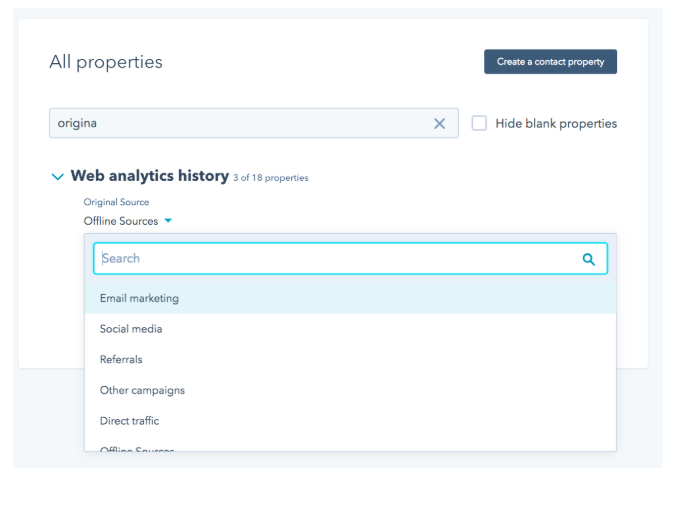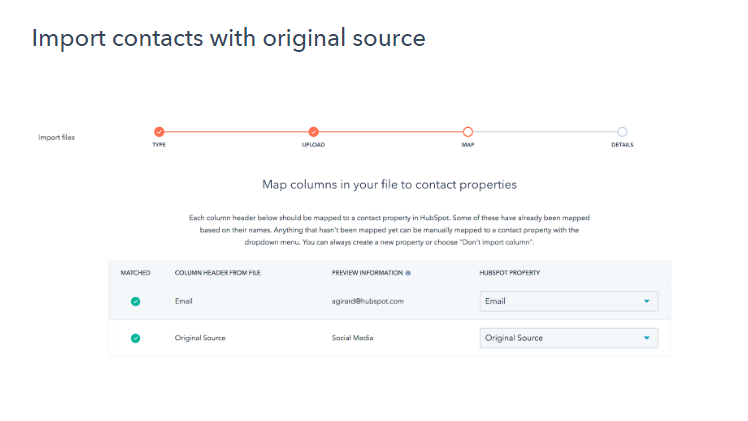In marketing, context is everything. Before you engage with your leads - no matter where they are in the sales funnel - you should always know how they first found your website as this will help to inform your lead nurture strategy and your discussions with them.
This first point of contact is referred to as a lead source.
What’s a lead source?
Well, a lead source – also known as “Original Source” in HubSpot – is, in the simplest of terms, the first channel through which a lead visited your website. Essentially: how they first found you.
This could be through a Google search, it could be by them clicking a link to your website on another website, or it could be as simple as them clicking a link in a tweet that takes them to your website. All of these examples are potential lead sources but there are many more.
A couple of examples:
-
If I visit a website via a Google search and later convert via a form on that website – becoming a lead in the process – my lead source will be “organic search” as it’s how I first found that website.
-
If I click on a paid advertisement on a search engine results page, land on the website, and later convert via a form on that website, again becoming a lead in the process, my lead source will be “paid search”.
-
If I click on a link on a website which directs me to another website and then converts to that website, my lead source will be "referral".
-
If I click on a link on social media which directs me to another website and then convert to that website, my lead source will be "social media".
-
If I click on a link in an email to arrive on a website and then convert on that website, my lead source will be "email marketing".
You get the idea.
Why is a lead’s source important?
As mentioned previously, context is everything. If you know how leads first arrive on your website you can tailor your marketing and sales efforts accordingly.
For instance, let’s say you provide a CRM solution called “Super CRM” and you want to generate more bottom-of-the-funnel (BOFU) leads via your pricing page. With this in mind, you set up a pay-per-click (PPC) advertisement targeting a specific search term – “Super CRM pricing”.
As your PPC advertisement targets a specific search term and is tied to a bottom-of-the-funnel content offer, you know that anyone searching for “Super CRM pricing” and converting on the pricing page is interested in what you have to sell – and therefore further through the buyer’s journey.
So if a lead’s original source is “paid search”, we know that they are either considering the options available to them or potentially ready to make a purchase as they are further through the buyer’s journey. We can then use this information to inform our lead nurture strategy and personalise engagement.
Conversely, leads with a lead source of “social media” will most likely be at an earlier stage in the buyer’s journey and perhaps conducting research to learn more about your business and the services it provides. Most of these leads will need to be comprehensively nurtured until they are ready to engage with your sales team.
That said, lead sources are not the be-all and end-all of the buyer journey. Someone might be ready to make a purchase on your website but first, arrive via a blog. Similarly, a lead might be receiving lead nurture emails but only interested in education and not prepared to buy anything.
How can lead sources help you manage your marketing efforts?
Lead sources and reporting go hand-in-hand – with lead sources you can see which channels drive the most conversions on your website, and which of those conversions actually turn into customers.
For example, if you generate 70% of your customers via organic search – wouldn’t it be best to further invest in organic search, rather than try to obtain more customers via channels that do not convert anywhere near as well?
Lead sources enable you to be more pragmatic about your marketing activity – instead of investing in channels that do not generate leads or customers for your business, you focus on those that do, saving money and maximising your return on investment (ROI). You can also build workflows around them to focus on specific leads.
If you run a start-up, small or medium-sized business, investing in the channels that deliver returns (at least, at the beginning) will be far more beneficial in terms of potential business opportunities. For large corporations, the marketing budget can most likely be spread across several channels for an extended period of time. For smaller businesses, the investment must be strategic and tied to specific business goals.
Furthermore, by understanding just what channels drive website traffic and lead generation for your business, you can start to tailor content for those specific channels. For instance, if most of your leads arrive via organic search, creating more blogs and web pages (which can be found by search engines and searchers) will support that activity. Similarly, if you find that a lot of your leads and customers are generated via paid advertising, creating further paid advertising collateral, landing pages and bottom-of-the-funnel content offers (such as product or service landing pages) will help, too.
How do lead sources work in HubSpot?
Now that you know what lead sources are, how do they work in HubSpot?
A lead source is a contact property in HubSpot that cannot be edited – and is called an “Original Source”. The original source value is automatically set when a website visitor first arrives on your website, so if a website visitor first arrives on your website via organic search, regardless of how they then convert on your website – be it through email, paid search etc – their original source will be organic search.
You can use original sources in HubSpot to create lists and segment your contacts according to how they found your website, providing an excellent way for you to quickly see what your most effective marketing channels are.
If you want help with lead management, we run classroom-based lead management workshops. Click here to find out more.
Where can you find a contact’s original source?
To find a contact’s original source, simply go to your HubSpot dashboard, click Contacts in the top right, and then Contacts from the drop-down menu. You should see a list of all your contacts. Navigate through and find the contact you are looking for, click on them and then you should see their profile with their original source value defined on the left.
These are the original source values recorded in HubSpot by default:
-
Social media
Twitter, Facebook, and LinkedIn – all of these social media channels can be used by interested parties to help find your business online. Leads generated via social media will typically be at earlier stages in the buyer’s journey and conducting research to find out more about your business and what it does.
-
Organic search
Search engines like Google and Bing, for example, are another way for interested parties to find your business online. Leads generated via organic search are most definitely interested in what your business does, but will typically be at earlier stages in the buyer’s journey.
-
Paid social
Leads generated via paid social – advertisements on social media platforms like Facebook, LinkedIn and Twitter – are further into the buyer’s journey and most likely considering their options or ready to make a purchase.
-
Paid search
Like paid social, leads generated via paid search are further into the buyer’s journey and are considering their options or ready to make a purchase. Most of us don’t click on paid advertisements unless we are considering or about to make a purchase.
-
Referrals
Referrals are clicks from links on other websites to your website.
-
Direct traffic
Leads generated via direct traffic have either first visited your website by typing its URL in or first accessed it via a channel or source that cannot be tracked by HubSpot. For example, website visitors who first visit your website via a link shared over WhatsApp cannot be tracked and are instead considered “direct traffic” when they convert.
-
Offline sources
Offline sources refer to contacts and customers who originated outside of your website, such as those who have been imported in. Offline sources are hidden by default in HubSpot.
-
Other campaigns
If you have any campaigns that are being monitored with specific tracking URLs, leads generated via these campaigns will be assigned the “other campaigns” original source value. You can, of course, set up custom tracking so you can use sources outside of the above selection. If you want to find out more, why not check out this blog?
If you're using things like traditional advertising, direct marketing, affiliate/partner programmes, events and shows, it's important to track leads generated via these channels and then add them to your HubSpot portal to get an accurate view of overall lead generation.
Edit a contact's original source in HubSpot
A recent HubSpot update means that it's now possible for you to edit a contact's original source. This update is particularly useful because it ensures that your lead reporting is actually accurate. For example, if you import a list into HubSpot from another CRM, the contacts will be assigned a lead source of "offline", which isn't correct. With the new update, you can fix that with ease.

You can also update contacts in bulk from the Contacts dashboard or through a workflow, as well as choose a contact's original source when you add them to HubSpot.

The 'first page seen' contact property
The 'first page seen' contact property is a type of source in the content marketing world. It enables marketers to understand just what content a contact looked at when they first arrived on the website. For example, if you have content that's bringing in a lot of views, leads and customers, you can put a value against all of your contacts whose first page seen was that page.
This property gives you an indication of what content generates the most activity for your business and allows you to be a bit more strategic about your content creation (if you know what brings in leads and customers, do more of it).
Put your sales team in a better position to engage
Your sales team is a precious resource and their time should be preserved for the best leads. If you can provide your sales team with information on how leads arrived on your website, including what those leads have subsequently engaged with since converting, your sales team will be able to better lead the conversation and not get stuck!
This kind of information is gold dust and can often make the difference between a closed/won deal and a closed/lost deal.
Knowing just how your leads first found your website will help you to improve your engagement and develop nurturing strategies for leads at every stage of the sales funnel. If you're using HubSpot and want to get the most out of it and improve your marketing and sales activity, why not check out our 50 HubSpot Hacks for a series of actionable tips and tricks?









.png)





